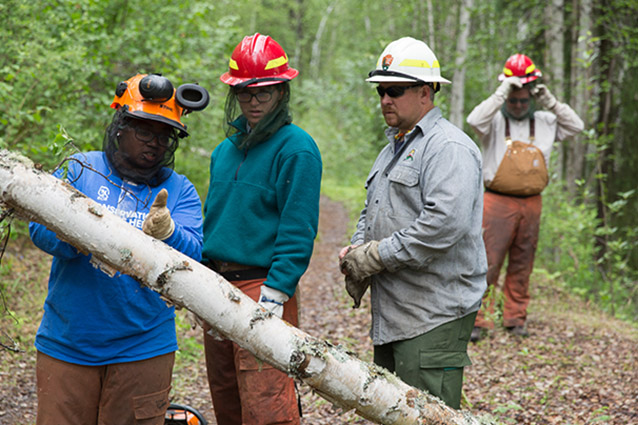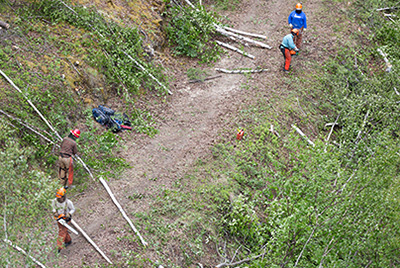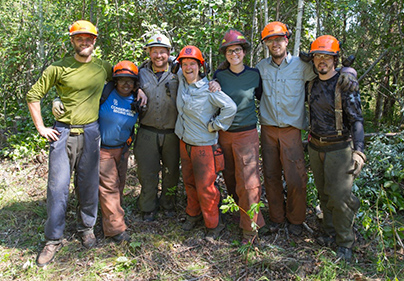Assigned to a remote Alaskan coal camp, Student Conservation Association crews gained new fireline skills, enhanced understanding of fire ecology and fire management, and an appreciation for the importance of historic site conservation efforts.
To kick off the adventure, the group embarked on a 105-mile boat ride on the Yukon River from Eagle, Alaska to the Coal Creek Camp.

NPS/Yasunori Matsui
For the past two summers, Yukon-Charley National Park and Preserve staff and college-aged Student Conservation Association (SCA) crew members have worked together to implement fuels reduction projects in the historic Coal Creek Mining District. In 2015 and 2016, six students spent eight days in June working and camping in the mining district, gaining experience on how to effectively communicate while working side by side with land management and fire professionals.
The SCA members met with the Eastern Area Fire Management staff at the park, where they received an overview of the National Park Service mission and goals and discussed the roles of fire ecology and fire management in the park. This open dialogue provided SCA members insight and understanding about the area where they would be working. To kick off the adventure, the group embarked on a 105-mile boat ride on the Yukon River from Eagle, Alaska to the Coal Creek Camp. There are no road systems to the camp so the group travelled by boat while all supplies and gear were flown in by helicopter.
Once at Coal Creek Camp, fire management staff spent the first three days teaching the SCA crew and other NPS employees the full S-212: Wildland Fire Chainsaw course. This training provided the skill set needed to safely operate the chainsaws they would be using while working on the project. In addition to classroom course, the students received field training on operating chainsaws and how to properly fall/limb trees and brush.

NPS/Yasunori Matsui
An important aspect of any field work is risk management. The students were trained on the importance of being “Bear Aware” in remote areas of Alaska. They learned how to operate radios, received an overview of fire helicopter operations, and received training on how to recognize and implement emergency evacuations if someone were to get hurt.
After training was complete the SCA crew, along with fire management staff, operated chainsaws and brush cutters to remove trees and brush along a 3.8-mile road corridor, creating a fuels/fire break to help defend against the threat of wildland fire to the Coal Creek Historic Mining District. Vegetation maintenance had not been completed along the road for more than 10 years, so hundreds of hazard trees left standing after fires in 2004 and 2008, and other dead and downed material needed removal.
The SCA crew also learned about the mining history of Yukon-Charley and the Coal Creek Historic Mining District. The crew toured a gold dredge, cooked and ate meals in the historic mess hall, and slept in the historic mining cabins.

NPS/Yasunori Matsui
Eastern Area Fire Management staff empowered the SCA crew and mentored potential future employees in resource stewardship by applying fire mitigation strategies that allow naturally occurring fires to burn for resource benefit. Additionally, this experience opened the door for these students to appreciate and explore a different culture, which may in the future help to foster a new set of stewards for the national parks.
With the National Park Service Centennial this year, #FindYourPark was a key message shared with the SCA crews, helping them to understand the importance of the historic mining district and getting them in touch with pieces of their heritage and national treasures.
Last updated: December 14, 2017
